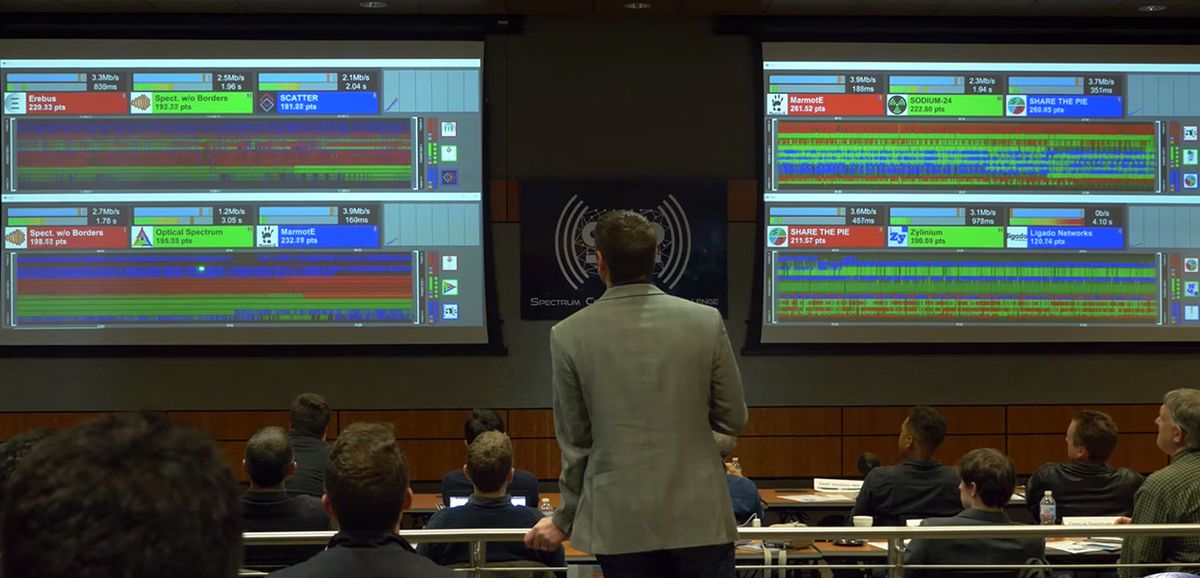In a room at Johns Hopkins University in Laurel, Md., banks of radios and racks of servers simulate the complicated, noisy environment of radio transmissions. The room, nicknamed the Colosseum, is the arena for the U.S. Defense Advanced Research Projects Agency’s latest challenge. DARPA wants to solve the problem of utilizing the finite amount of radio spectrum available in the most efficient way possible, using machine intelligence.
“Our demands for spectrum are going up and up exponentially,” says Paul Tilghman, project manager for the Spectrum Collaboration Challenge. DARPA is hoping the challenge inspires teams to find methods that will let devices manage their use of the spectrum autonomously in the face of those exponentially growing concerns.
The traditional methods of spectrum management, where radio frequency ranges are chopped into sections and set aside for specific uses, isn’t enough to keep up with the number of devices sending signals these days. We need active spectrum management, says Tilghman. The best way to accomplish that is to find a way for devices to manage their transmissions on their own.
The problem is that radios can’t broadcast at the same time—at least, not on the same frequency. If they do, their signals jumble together or cancel each other out. But it’s theoretically possible to get more radio transmissions in the same amount of spectrum.
When a radio transmits, it goes deaf. Tilghman says it’s like plugging your ears every time you shout—for radios, this means they can’t hear another transmission coming in while they’re transmitting out. If another radio decides to transmit at the same frequency at the same time, the signals will interfere, and the radios will be none the wiser, because neither could hear the other radio.
Autonomous management by the transmitting devices will hopefully solve this problem, by training machines to listen for open frequencies in the constant noise of transmissions all around them and only sending their own signals when a window opens up. The hard part is writing the algorithms that will teach those machines.
Enter the Colosseum. In the room, 128 functioning radios are clustered together, stripped of their antennas and broadcasting their signals directly into cables that feed directly into a 22-server emulator of real-world scenarios. The Colosseum can run hundreds of scenarios in a row to figure out which spectrum management algorithms work best. Teams competing from around the world have been able to send their algorithms in to be tested without ever having to worry about traveling back and forth themselves. Until earlier this month, that is.
19 teams qualified to compete in the first, year-long round of the challenge, which will ultimately last for two more years. Last January, DARPA opened the doors for the competition, inviting any applications from teams who thought they were up to the task. Thirty teams qualified and have had access to the Colosseum for the past year. They’ve gone head to head in round-robin style scrimmages each month to narrow the field to the 19 that competed in the last series of contests that ended on 13 December.
Of those 19 teams, the 10 with the algorithms that best managed the crowded spectrum each won $750,000 to continue develop their solutions. But Tilghman says everyone is free to continue into the next round of the competition—the prize money is meant to function as seed money to help foster the most promising designs.
The 10 best teams came not just from universities—Vanderbilt, Northeastern, and a joint group from Purdue and Texas A&M, to name three—but defense companies BAE Systems and Northrop Grumman. Two of the teams consisted of independent engineers and software developers. The complete list is here.
One of DARPA’s previous competitions, the Grand Challenge, similarly tackled another massive problem—figuring out how to design an autonomous car. The Grand Challenge was instrumental in kicking off the self-driving vehicle industry into the massive unertaking it is today.
But getting autonomous radios to govern themselves in an ad hoc fashion is much a more difficult nut to crack than getting cars to autonomously identify and respond to their surroundings. The radio spectrum is a noisier environment than roads and highways, and it’s a lot less orderly. The rules of the road are well laid-out, and when one car hits another, it’s relatively easy to track what happened. There’s no real equivalent set of rules for spectrum management. And because radios become deaf when they transmit, it can be a lot more difficult to track what happened.
“We’re on a long road to radio autonomy,” says Tilghman, noting that DARPA has been tackling some version of this problem for a decade and a half. And solving the technical problem is only half the challenge—there is a tremendous amount of national and international policy questions to answer as well. But Tilghman hopes that by keeping the policy people in the loop as the technology develops, it won’t be long until autonomously-managed spectrum becomes available.
Michael Koziol is the news manager at IEEE Spectrum. Previously, he was an associate editor covering telecommunications. He graduated from Seattle University with bachelor's degrees in English and Physics, and earned his master's degree in science journalism from New York University.



